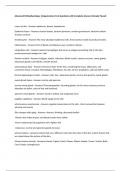Advanced Pathophysiology- Integumentary Test Questions with Complete Answers Already Passed
Layers of skin - Answers epidermis, dermis, hypodermis
Epidermis layers - Answers stratum basale, stratum spinosum, stratum granulosum, stratum lucidum,
stratum corneum
Keratinocytes - Answers The most abundant epidermal cells, they function mainly to produce keratin.
Melanocytes - Answers Part of Basale and Spinous Layer, produce melanin
Langerhans cells - Answers special macrophages that serve as antigen-presenting cells in the skin;
present processed antigen to t-cells
Dermis contains - Answers Collagen, elastin, reticulum, Blood vessels, sensory neurons, sweat glands,
sebaceous glands, hair follicles, smooth muscle
subcutaneous layer - Answers innermost layer of the skin, containing fat tissue, adipocytes, and
connective tissue. Contains Macrophages, fibroblasts, fat cells, nerves, lymphatics, and hair follicle roots
Dermal appendages include - Answers nails, hair, sebaceous glands, eccrine and apocrine sweat glands
sweat glands types - Answers eccrine and apocrine
eccrine sweat glands - Answers Thermoregulation: Secreting glands, are far more numerous and are
abundant on palms, soles of feet and forehead.
apocrine sweat glands - Answers found in axillary and anogenital areas
papillary capillaries - Answers blood supply to the skin
arteriovenous anastomosis - Answers regulate temperature at the skin - direct connection between
arteriole and venule
Skin changes with aging - Answers -dryness, thinning, deceased elasticit
-thinner skin makes bruises and blood vessels more visible
-fewer melanocytes &Langerhans cells =lighter skin
-sebaceous, eccrine and apocrine glands decrease
primary lesions - Answers Lesions that are a different color than the color of the skin, and/or lesions that
are raised above the surface of the skin.
Primary lesions include - Answers Macule, Papule, Patch, Plaque, Wheal, Nodule, Tumor, Vesicle, Bulla,
Cyst, Pustule, telangiectasis
, Macule - Answers flat, colored spot on the skin <1 cm diameter
Papule - Answers small, solid skin elevation, <1 cm diameter
patch - Answers a flat, discolored irregular-shared area on the skin larger than 1 cm
Plaque - Answers elevated, firm, rough lesion with a flat top surface. >1 cm in diameter
Wheal - Answers small, round, irregular shaped raised area on the skin that may be accompanied by
itching; usually seen in allergic reactions; size varies
Nodule - Answers solid, round or oval elevated lesion 1-2 cm in diameter
Tumor - Answers elevated and solid lesion; may or may not be clearly demarcated; deeper in dermis;
greater than 2 cm in diameter
Vesicle - Answers elevated, circumscribed, superficial, not into dermis; filled with serous fluid; less than
1 cm in diameter
Bulla - Answers large blister; serous fluid >1 cm
Pustule - Answers elevation of skin containing pus
Cyst - Answers Elevated, circumscribed, encapsulated lesion; in dermis or subcutaneous layer; filled with
liquid or semisolid material
Telangiectasia - Answers Caused by vascular dilation; permanently enlarged and dilated blood vessels
that are visible on the skin surface.
secondary lesions - Answers Skin damage, developed in the later stages of disease, that changes the
structure of tissues or organs.
secondary lesions include - Answers Scale
Keloid
Fissure
Erosion
Ulcer
Excoriation
Scar
Lichenification
Atrophy




